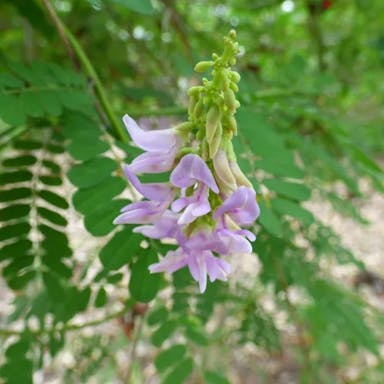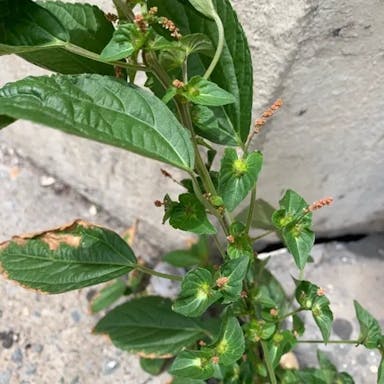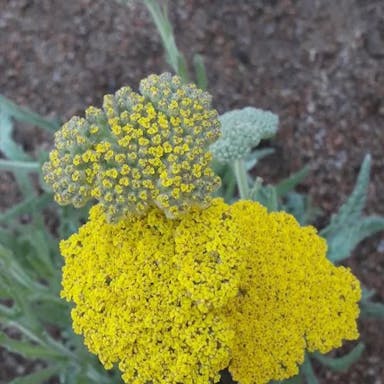Broom snakeweed, scientifically known as Gutierrezia sarothrae, is a perennial plant native to North America, particularly found in arid regions. It belongs to the Asteraceae family and is characterized by its slender, wiry stems and small, bright yellow flowers that bloom in late summer to fall. The plant typically reaches a height of 1 to 3 feet and has a bushy appearance. Gutierrezia sarothrae produces small, dry fruits that are dispersed by wind. It is known for its drought tolerance and ability to thrive in poor, sandy soils, making it a resilient plant for xeriscaping. This plant is often used for erosion control and as a forage plant for livestock due to its high protein content. Snakeroot is an important native plant found throughout the Americas in many different ecosystems. It thrives in dry, sandy areas where few other plants can survive. The small yellow flowers provide nectar for pollinators. It spreads easily by seed, making it excellent at stopping soil erosion. Ranchers value it as feed for cattle.
Broom snakeweed
- Scientific name
- Gutierrezia sarothrae
Basic Information
- Asteraceae Family Gutierrezia Genus Broom snakeweed Species
- Asteraceae > Gutierrezia > Gutierrezia sarothrae
- 83%
- The Completeness of This Encyclopedia
Please help us complete the encyclopedia, Terrarium is a encyclopedia service to be completed with everyone in the world. Currently, this page is 83% complete. For more information on how to contribute, please click here.
- Forb/herb
- Perennial
- Subshrub
- Height
- 30cm ~ 100cm
- Flower Color
- Leaf Color
- Anthesis
- summer, fall
- Sunlight Exposure
Full Sun Long hours of sunlight from morning to afternoon Partial Shade A location in the shade of a tree or where either the morning or afternoon is shaded Full Shade A place where there is no direct sunlight
- Full Sun
- Hardiness Zones
This is an indicator to know to which zone each plant can winter. Knowing the zone of each plant gives you an idea of the cold temperature resistance when grown in the ground without a roof. 2: -42.7 to -40.0 3: -39.9 to -34.4 4: -34.3 to -28.9 5: -28.8 to -23.3 6: -23.2 to -17.8 7: -17.7 to -12.2 8: -12.1 to -6.7 9: -6.6 to -1.1 10: -1.0 to 4.4 11: 4.5 to 10.0
- 4
- Cold resistance
- Good
- Heat resistance
- Good
- Habitat of origin
- United States
- Growth Rate
- Normal
What is Broom snakeweed (Gutierrezia sarothrae)?
What is Broom snakeweed (Gutierrezia sarothrae)
Flower meaning
Each month and date have a designated birth flower. The flower language used in America for Broom snakeweed has meanings such as happiness, healing, and protection. The bright yellow blossoms represent happiness.
Calendar of Broom snakeweed (Gutierrezia sarothrae)
Calendar
Broom snakeweed typically blooms from late summer to early fall in the United States. Occurring once a year, blooming lasts for about 4-6 weeks. The flowers are at their best during the month of September when vibrant yellow hues are displayed. To extend the blooming period, faded flowers should regularly be deadheaded to encourage new blooms. In addition, provide well-drained soil and ample sunlight so that these can promote prolonged flowering. Proper watering practices should be maintained, over-fertilization should be avoided, and good air circulation around the plant should be ensured to also contribute to a longer blooming season.
How to grow Broom snakeweed (Gutierrezia sarothrae)
Watering
Broom snakeweed requires adjusted watering frequency on seasonal variations. During growing season in spring and summer, water the broom snakeweed every 7-10 days. In fall and winter, reduce watering to every 14-21 days for preventing overwatering. Broom snakeweed requires well-draining soil avoiding waterlogged conditions leading to root rot. Water the broom snakeweed thoroughly, allowing excess water to drain out from pot's bottom preventing water accumulation. Check soil humidity by inserting finger 1-2 inches into the soil; water when topsoil feels dry.
Soil and Fertilizer
Broom snakeweed thrives in well-drained sandy or gravelly soils with a pH range of 6.0 to 8.0. The plant prefers full sun exposure and is drought-tolerant once established. Apply a balanced slow-release fertilizer in early spring to promote healthy growth of this plant. Monitor soil quality regularly to ensure proper nutrient levels for optimal growth. Adjust fertilizer based on soil test results. Reapply fertilizer in late spring if necessary, but avoid over-fertilization as it can harm the plant.
Sunlight and Place
Broom snakeweed thrives in extensive daylight, necessitating at minimum 6 hrs of direct sun everyday. It displays superior heat endurance, forming it appropriate for torrid climates. The flora can bear frigid temps below 10°F (-12°C), however extended revelation to freezing circumstances can impair it. During winter, it is prudent to shield it from frost by covering or relocating it inside. Broom snakeweed favors well-draining earth and ought to be set in a site with favorable air flow to prevent fungous maladies. It is paramount to evade overwatering, as the flora is drought-tolerant. In ideal settings, Broom snakeweed can bloom profusely, alluring pollinators to the area.
Advanced Information of Broom snakeweed (Gutierrezia sarothrae)
Pruning
Broom snakeweed requires regular pruning. Prune in late winter prior new growth. Utilize sharp, sterilized tools for precise trimming above leaf nodes or side branches. Discard pruned debris promptly. Habitual cutting back aids productive new shoots and vivid blossoms.
Planting and Harvest
Broom snakeweed is best potted for controlled growth and soil drainage. Place the plant in the center of the pot, ensuring the roots are spread out, and gently pack soil around them. Choose a well-draining pot or conainer with drainage holes and fill it with cactus or succulent soil mix. Water sparingly, allowing the soil to dry out between waterings, and place in a sunny location. If mishowed, trim back any leggy growth to encourage bushier growth. Repot every 2-3 years in a slightly larger pot to accommodate growth.
Propagation
Broom snakeweed can be propagated through seeds, division, and cuttings. Division involves separating the plant into smaller sections with roots attached. Cuttings can be taken from healthy stems. Leaf cuttings can also be used by taking a leaf. To ensure successful propagation, it is recommended to use a combination of these methods to increase the chances of success.
Pests and Diseases
Broom snakeweed is susceptible to various pests and diseases, including spider mites, aphids, and powdery mildew. These pests can weaken the plant by sucking sap or causing fungal infections, leading to stunted growth and yellowing of leaves. Controlling spider mites can be done by spraying the plant with water to reduce their numbers, while aphids can be controlled by hand or treated with insecticidal soap. Prevention methods for Broom snakeweed include regular inspection of the plant for early detection of pests, maintain proper air circulation, and avoiding over-fertilization. Powdery mildew, a fungal disease, thrives in humid conditions. To prevent it, leaving good air circulation around the plant, avoid overhead watering, and remove any infected plant parts promptly. Withering of Broom snakeweed can be caused by multiple pests and diseases, leading to a decline in overall plant health.
Habitat of Broom snakeweed (Gutierrezia sarothrae)
Habitat
Toxicity of Broom snakeweed (Gutierrezia sarothrae)
Health Benefits
- edible
- Inedible
- Toxic
- No toxicity
NO DATA
Toxic for dogs and cats
NO DATA
Q&A of Broom snakeweed (Gutierrezia sarothrae)
- What Are the Benefits and Uses of Broom Snakeweed?
Broom snakeweed is a perennial shrub with several medicinal and ecological benefits. Native Americans traditionally use this for treating snakebites, colds, and digestive issues. This plant requires soil stabilization and erosion control for its extensive root system. It provides a habitat for various insects and small mammals contributing to biodiversity. However, large quantities of broom snakeweed can be toxic to livestock.
- choice
Broom snakeweed provides two chief forms: 1) 'Gold Fleece' possessing brilliant yellow blooms and 2) 'Compacta' having a more packed habit. For sowing, favor plump, solid seeds missing indications of harm. Select young plants with healthy green foliage and sturdy stems, avoiding drooping or discoloring. Confirm roots are well-formed and not root-bound. Give priority to reputable providers to assure excellence. It is vital to choose the form best fitting your garden's needs and visual preferences. Frequently inspect for pests or illnesses when purchasing to stop any possible problems.











